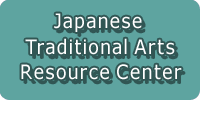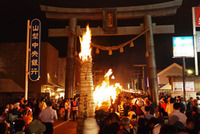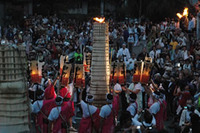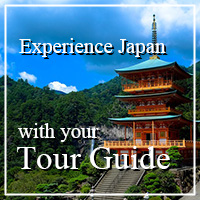

Total:35items
- Folk Performing Art (16)
- Kabuki (2)
- Noh & Kyogen (1)
- Festival (10)
- Wakubata woolen banner event of Kumakabuto Hatsuka Festival
- Hakone Feudal Lord's Procession Festival
- Uozu’s Tatemon Event
- Yama-age Event (Yama-age Festival)
- Yoshidanohimatsuri: Fire Festival of Yoshida
- Potato-comparing Festival in Nakayama, Oumi
- Noto's Kiriko Festival
- Ara-odori (Sankasho Shrine Festival)
- Mi-fune event in Kouchi Festival
- Nozawa Onsen Dosojin Festival
- Ritual & Ceremony (2)
- Puppet Play (2)
- Folk technology (2)

 |
|
 《Feature》
《Feature》Every year, on August 26 and 27, Yoshidanohimatsuri (Fire Festival of Yoshida) is held by Kitaguchi-Hongu-Fuji-Sengen shrine (Sengen shrine in short) and Suwa shrine in Kamiyoshida, Fujiyoshida-shi, Yamanashi Pref., marking the end of climbing season on Mt. Fuji.
On August 26
In the evening, they hold Hondensai (a ritual in Sengen shrine) and then have Suwajinjasai (a ritual in Suwa shrine). After that, O-Mikoshi (the grand mikoshi: portable shrines used in festivals) and Mikage (the mikoshi in the shape of Mt. Fuji) will be carried out from the shrine to the main road. They will parade around the parish district with many carriers, heading to Otabisho (places to rest mikoshi). After reaching there, they start lighting torches all around the parish district: they light more than 70 cone-shaped torches which are 3 meters tall, as well as the torches made for each house. At that moment, it looks as if the whole town is on fire, and the festival will last until late at night.
On August 27: Susuki-Matsuri (Miscanthus Festival)
In the evening, as the night falls, the two mikoshi will be carried back to Sengen shrine. The festival reaches the climax when they start being carried around Takamagahara (a square-shaped ceremonial place surrounded by sacred ropes), followed by parishioners walking behind the mikoshi with Susuki-no-Tamagushi (offerings which is made of miscanthus with small papers tied on it) in their hands. The ceremony proceeds in a solemn atmosphere while a great crowd of visitor and the mikoshi moving in one direction.
History
Originally, the festival belonged to Suwa shrine but not Sengen shrine. According to "Kaikokushi" (a chorography of the area around Yamanashi Pref. written in 17c), they lit bonfire all around Kamiyoshida village in an annual festival for God Suwamyoujin, who is the ubusunagami (gods which protects those who are born in a certain district from before their birth to afterlife) of the village, on 22 July. Originally, the festival had been led by the Sato family who is Shinto priests in charge of Suwa shrine. However, it is said that priests of Sengen shrine were involved in the festival as well.
A ceremony using fire has begun in Suwa shrine more than 500 years ago, and 100 years later, it already had a style similar to that in present days, according to old texts. A book named "Yoshidanoshinjukucyo"(1572), a document about the beginning of Kamiyoshida, refers to a path which mikoshi (The god) passing through. In addition, Oyamamikoshi (a mikoshi in the shape of Mt. Fuji) had already appeared in the ceremony 400 years ago, judging from old records.
Myths of the Festival
Many myths have been told about the festival's origin; some have association with Sengen shrine and some are about Suwa shrine; the most popular myth among them is that of the former one. Sengen shrine in Kamiyoshida worships Mt. Fuji. The mountain has several names as god; one of them is "Konohanasakuyahime". According to "Kojiki" (documents of ancient legends and history written around 6c), Konohanasakuyahime conceived a child after spending only one night with Niniginomokoto (an amatsukami: gods originated in heaven). However, Niniginomokoto suspected her of conceiving a child of a kunitsukami (gods originated on earth). As she was sure that children of an amatsukami must be protected whatever happens, she born children in a hut on which she lit fire to prove that her child's father is the amatsukami. Associated with this myth, Konohanasakuyahime is regarded as a god of fire prevention, easy childbirth, accident prevention, guardian of industry. Considering this story, it is said that the fire of the festival is symbolizing the fire lit by Konohanasakuyahime.
On the other hand, stories associating with Suwa shrine have been told in Kamiyoshida. In some of them, dragons and snakes play an important role. For example, a dragon or a Hebigami (snake gods) are said to come down along the river following the mikoshi. Regarding this myth, priests clean the river which runs through the premises; in addition, it is said that they shouldn't use rivers or make them dirty during the festival while a white snake will come down the river at the east and a black snake will go up the one at the west.
In connection with these myths, there is also a story of the festival's origin including a dragon. A monk was on his way back to Sainenji temple (a temple in Kamiyoshida), after practicing asceticism in Suwa district in Shinano (around Nagano at the present). He made a dragon from a brunch he took from a tree, and had Suwa Shrine enshrined it. Then he burned a cane on which he put the dragon on top. Thus, the fire burned the cane is said to be symbolized by the one in the festival.
Another tells that the fire's origin is that made for Takeminakatanokami (the god enshrined by Suwa Grand Shrine in Nagano). According to "Kojiki", Takeminakatanokami retreated to Suwanoumi (Lake of Suwa) in Shinanonokuni (same as Shinano), when he was fighting over the inheritance of Ashiharanonakatsukuni (Japan). It is said that torches he had in this battle is the origin of the fire festival. This story is also referred in detail in "Reizan-Fuji" (1909), written by Nakatani Takezou. In this book, the god is said to have ordered residents in the area around Suwanoumi to light many torches when he retreated. These lights made his enemy force believe that his reinforcement arrived. For this reason, the enemy raised the siege and left at the night of July 21, which was the date of the festival in the past.
Background of the Date
Nowadays, the fire festival is held on August 26 and 27 in solar calendar. However, the date was originally different as they had used the lunar calendar. On 1872, Japan had a calendrical reform and started using the solar calendar. However, they didn't adjust the festival dates to the solar calendar instantly; the fire festival was on July 21 of the lunar calendar; and the ceremony of the end of climbing season on Mt. Fuji was on July 26 of the lunar calendar. Therefore, the dates used to change from the middle of August to the beginning of September every year in the solar calendar. For example, in 1885, it was on September 1, in 1887, it was on September 8, and in 1908, it was on August 19, according to a local newspaper.
In early 1910's, they tried to fix the festival dates in the solar calendar for the first time. At first, they stop using lunar calendar and held festival on August 21 and 22 in 1910.
*From next year, they held discussions for several times to fix the most ideal dates, considering the season and the residents' convenience; in August 1914, they finally succeed in fixing the date to August 26 and 27.
[National Important Tangible Assets of Folk Culture]
Provided by: Fujiyoshida Kankou Shinkou Service (Fujiyoshida Tourism Promotion Service)
Translation: Aki Tobayama, reviewed by Chan Yitin
| City/Town | Fujiyoshida-shi, Yamanashi pref. |
|---|---|
| Location | Kitaguchihongu-fujiasama jinja Shrine and Suwa jinja Shrine |
| Contact | Fujiyoshida Kankou Shinkou Service (Fujiyoshida Tourism Promotion Service)
TEL 0555-21-1000 FAX 0555-21-1001 |
| Access | By train
Shinjuku Sta.---(JR Chuo Line: Limited Express/1h)---Otsuki Sta.---(Fujikyu Railway: Limited Express/35min)---Fujisan Sta. Shinjuku Sta.---(JR Chuo Line: Holiday Rapid Fujisan/2h)---Fujisan Sta. By Bus Shinjuku Sta.---(Keio Bus: Chuo Kosoku Bus/1h45min)---Fujisan Sta. By car On Expressway ・Tokyo---(Tomei Expressway/83km)---*Gotemba I.C.---(R138/10km)---Subashiri I.C.---(Higashi-Fujigoko Road9.5km/)---Yamanakako I.C.---(Higashi-Fujigoko Road/8.5km)---Fujisan Sta. *Gotemba I.C.---(R138/22.5km)---Fujisan Sta. ・Osaka ---(187.3km)---**Nagoya---(Tomei Expressway/187.3km)---Fuji I.C.---(64km)---Kawaguchiko **Nagoya---(Tomei Expressway/225.1km)---Gotemba I.C.---Fuji Sta. On Chuo Free Way ・Shinjuku---(Chuo Free Way/85km)---Kawaguchiko I.C. |
| Highlight/POI | ・The powerful scenery in the climax of the first day's event, which looks as if the whole town is on fire.
・A great crowd and two mikoshi moving in one direction with the solemn atmosphere in the second day's event. |
| General Participation | ・Watching the event
Date: August 26,27 (every year) Place: Fujiyoshida-shi Yamanashi Pref./ Kitaguchi-Hongu-Fuji-Sengen Shrine and Suwa Shrine |



